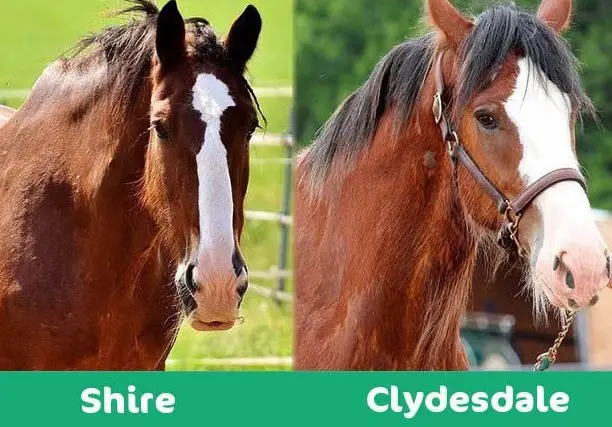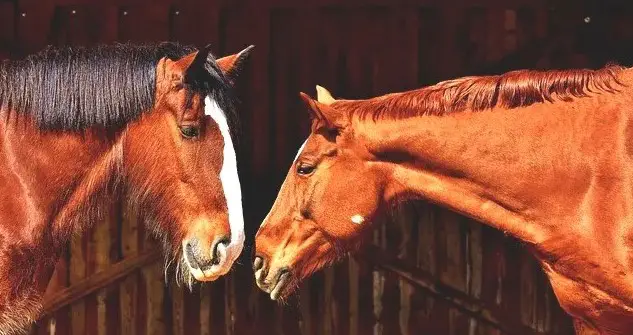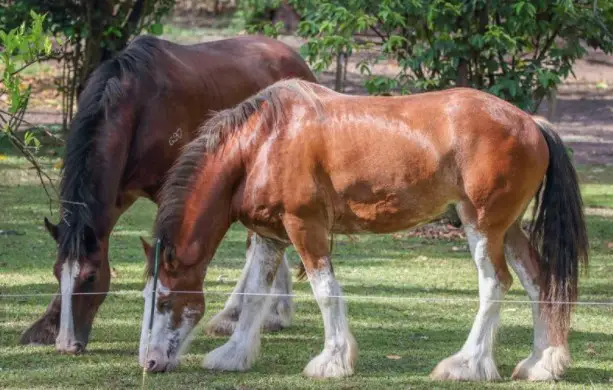Are you giving a thought to owning a beautiful equine friend? New and old horse owners have a tough time recognizing the difference between Shire horse and Clydesdale, alike. Moreover, new horse owners often have difficulty in setting apart one breed from another.
Have you ever compared Shire horse vs. Clydesdale and thought to yourself, “Is there a difference?” If yes, then you’re not alone.
Equine terms, like foal (young horse), colt (young male horse), filly (young female horse), stallion (adult male horse), or mare (adult female horse), could be a little bit intimidating for newbies. Rest assured, though, because this article is thoroughly researched, compiled, and crafted for you to understand even the most difficult of terms. So, delve further and learn as you compare Shire horse vs. Clydesdale.

Differences and Similarities
History
Shire horses originated from England. Historians believe that knights use Shire horses in battle, but some disagree. Farmers used Shire horses for plowing fields as time passed because of their incredible pulling power. In modern times, the use of horses for manual labor became less frequent, and the numbers of Shire horses dropped significantly. Experts classify Shire horses as endangered, reaching their digits as low as about 1500 left.
On the other hand, Clydesdale came from Scotland and got its name from the Clyde River. With the ever-changing demand for the qualities of horses, Clydesdale adjusts with the times.
Physical Characteristics
In comparison, Shire horse is slightly larger than Clydesdale. Shire horses can grow up to 19 hands, while Clydesdale measures around 17 hands (more about these later).
Hands are the unit of measurement for horse height, equivalent to 4 inches. When there was no standard form of size in ancient times, people used their hands to count equine peaks, which is still practiced today. Though some use modern ones like meters and feet-inches, you may come across hands as a form of measurement by breeders or even enthusiasts alike.

However, it’s difficult to tell a Shire horse vs. a Clydesdale just from one glance. Both have colors ranging from bay (brown or reddish-brown with black mane, tail, ears, and feet), grey, black, and chestnut on some occasions. Clydesdale may be roan, meaning they have colored and white hair on their body while solid on mane, tails, and legs.
Feathered feet are due to significant bone structure. Since these two belong to giant breeds of horses, they exhibit a trait resembling bell-bottom pants.
As mentioned at the start, Shire horses have a distinction from Clydesdale in that the former is slightly more extensive and more broadly built. Speaking of build, an average weight of a Shire Horse is 2000 pounds, while Clydesdale weighs around 1700 to 2200 pounds.
Uses
Both Shire horse and Clydesdale are draft horses, meaning their primary use before World War I was to pull carts and wagons.
They are also suitable for heavy jobs due to their large build. The two breeds mentioned above of horses are also highly suitable for transporting goods. Shire horse and Clydesdale are famous for leisure activities, e.g., equestrian and trail riding. Each has its catchy colors that attract people, so in the United Kingdom, these horses participate in parades and processions as they have a calm and docile demeanor.
Maintenance
In terms of equine grooming on both breeds, they need moderate grooming as they are pretty easy to handle and manage. However, they are equally challenging to take care of because of their large build.

Feathered feet require attention as they are a frequent source of infection. Remember to dry them thoroughly because they often touch the ground. As to other aspects, they’re the same as regular equine grooming. Though a horse doesn’t require baths, it’s important to bathe them every once in a while to remove dirt, but take note that excessive bathing may deprive them of needed oils on the hair.
Behavior
A side-by-side analysis of dealing with Shire horse vs. Clydesdale shows that both are very cooperative. Experts term this as cold-blooded, of course, not as reptiles, but because they maintain their cool even in the toughest of situations. Rare are the times they lose their temper and run wild over something.

Furthermore, you may have difficulty climbing, though, as they are not your average ponies. However, no worries, they are generally known as “gentle giants” for they are friendly, calm, and sweet. So, please don’t get fooled by their size because they are novice-friendly, especially when you train with them. On farms, they usually get the work done and are incredibly hardworking.
Which One Should You Pick?
No matter which one of these horses you choose, you will end up with a friendly, smart, and calm new friend. Both horses are excellent for riding and ground sports, like polo. Additionally, both horses are beautiful in look. So, in the end, it all comes down to you and your preference.
Conclusion
Like many other animals to study, horses are very intriguing and possibly mysterious to some. But this shouldn’t be a hindrance just because there is no one to teach you various points about horse breeds. You may come across this article in hopes of analyzing two almost-similar equine species.
While comparing Shire horse vs. Clydesdale is quite hard, it’s still possible to differentiate. A little observation here and there, sound research, and a keen eye make up a successful identification of which breed of horse is which. May you have fun studying horses, be it for a hobby or work.
As these breeds are so rare, you might find yourself shedding some extra cash. Shire Horses range from around $2000 to $20000, while Clydesdale costs $1000-$5000. You’re in good hands if someone you know lets you adopt theirs. The author wishes you the best of luck, and may you find what your heart decides.
